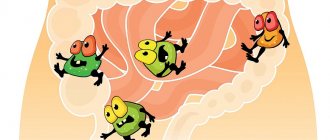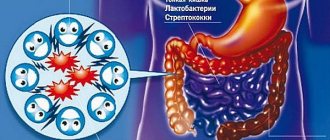Symptoms of dysbiosis in adults
Symptoms of dysbiosis in adults may be as follows:
- Diarrhea. Diarrhea due to dysbacteriosis occurs due to the fact that an excess amount of bile acids accumulates in the human intestines. They contribute to the fact that water from the intestines is less absorbed, contribute to loosening of stools, and disrupt the integrity of the mucous membrane of the digestive organ.
- Constipation. This symptom is typical for people over 50 years of age suffering from dysbiosis. Often such patients have a history of chronic colitis and atherosclerosis. Long delays in defecation are due to the fact that the intestinal microflora becomes incompetent and cannot normally stimulate contraction of the colon.
- Flatulence is also a symptom of dysbiosis in adults. It occurs due to the fact that the process of removing gases from the intestines is disrupted, and their formation increases. Due to bloating, the patient begins to experience painful sensations, possibly an unpleasant taste in the mouth, pain and burning in the heart area, nervousness, fatigue and weakness. When flatulence is acute, the patient may develop dyspeptic asthma with severe shortness of breath, coldness of the extremities, dilated pupils and severe bloating. (
Fever and fever
From the above it is clear that the temperature does not rise in all cases, but can be significant. Doctors note that the temperature usually does not exceed 39.5 degrees Celsius. Pediatricians believe that this is not dangerous for children (over 3 months) who can tolerate high temperatures.
The elevated temperature is due to the presence of inflammation. This is a general clinical sign of fighting infections. Many patients think that when the mercury on the thermometer reaches 38 degrees, immediate action must be taken. Action plan if a temperature appears due to dysbacteriosis:
- A mark within 37 degrees shows that the body knows about the disease and has taken control measures. There is no need to lower the temperature. General measures are taken for treatment (rationalization of diet, taking medications, prebiotics and probiotics, intoxication).
- When reaching 37 degrees, vomiting is sometimes observed. The first step is to eliminate the signs of dyspepsia. Sorbents help by absorbing toxins, which are the primary sign of changes in body parameters. Then the temperature is measured.
- When you reach the 38 level, you should for the first time seriously think about lowering the degree (detailed recommendations are given below in the text). This state of affairs indicates that the body cannot cope with the invasion, additional help is needed. Along the way, supplements and food enzymes are taken, and the cause of hyperthermia is eliminated.
- When the bar exceeds 39, you need to call an ambulance so that doctors can relieve the fever with an injection.
Causes of intestinal dysbiosis
Intestinal dysbiosis is a secondary disease; it never occurs on its own, but is always a consequence of certain exogenous and endogenous factors.
So, the causes of intestinal dysbiosis may be the following:
- Iatrogenic dysbiosis develops due to taking any medications that have a direct effect on the normal intestinal microflora. These may be antibacterial agents, hormonal drugs, cytostatics, sulfonamide drugs, histamine blockers, tuberculostatics, immunosuppressants, antacids, drugs that have a laxative effect. Surgical intervention is another reason for the development of iatrogenic dysbiosis.
- Improperly organized nutrition, in which the human body does not receive the required amount of components it needs, can provoke the development of dysbiosis. It also occurs due to the consumption of various chemical additives contained in foods. Provoking factors are often disruptions in the usual diet and a sharp change in the usual diet.
- Psychological reasons can negatively affect the functioning of the intestines and cause disturbances in its microflora. It should be noted that stress dysbiosis was identified by scientists quite recently. Previously, it was believed that emotional shocks were not capable of influencing the reproduction of intestinal microflora.
- Infectious bowel diseases.
- Diseases of the digestive system. This could be gastritis, cirrhosis, hepatitis, pancreatitis, gastric ulcer, etc.
- The acclimatization process often leads to digestive problems and disruption of the intestinal microflora.
- Disturbances in the functioning of the immune system, endocrine diseases, metabolic disorders.
- Intestinal motility disorders.
- Parasitic invasions, for example, giardiasis, trichomoniasis, helminthiasis, contribute to the destruction of normal intestinal microflora and the colonization of it by pathogenic bacteria.
- Oncological diseases, diabetes mellitus.
- Senile age can lead to disruption of the functioning of the intestinal microflora as a result of age-related changes occurring in the body.
Sometimes almost completely healthy people can suffer from dysbiosis. In this case, the reason should be sought in the characteristics of the profession, or in seasonal changes in nutrition.
Clinical signs
Before considering the bacterial picture, it is logical to give a general idea of what clinical signs are associated. The idea is formed from the functions of obligate flora, which form immunity, produce vitamins, and ferment proteins and complex carbohydrates. All of the above is violated. Immunity decreases, vitamin deficiency develops (group B, K and PP), the body is poisoned by toxins. A similar picture is superimposed by the specific action of pathogenic flora:
- Reduced mucosal resistance (to colonization).
- Disorder of the motor function of the intestines and its circulation.
- Decreased detoxification function.
- Weakening of the immune system.
Gastrointestinal dyspepsia
Dyspepsia refers to a complex of harmless symptoms associated with a disorder of the digestive system: bloating, flatulence, pain on palpation along the colon (Greek Omega form), heartburn, belching, vomiting and nausea. There is diarrhea, the stool is liquid, sometimes foamy, smelly or sour. Traces of blood and blue mucus may be present. Bloating is sometimes observed separately in the right and left hypochondrium.
The dominance of Proteas provokes frequent, loose stools (6-8 times daily). The feces are foamy, greenish in color, and have an unpleasant odor. Pseudomonas aeruginosa forms the appearance of feces, according to its name. The excrement is full of mucus. Staphylococcus aureus provides a complex of symptoms that manifest itself similarly to Proteus; instead of an unpleasant odor, streaks of blood may be present. The color of the stool is greenish.
Intestinal malabsorption
Carbohydrates are poorly absorbed, and diarrhea constantly plagues. Against this background, there is a complex of deficiency of vitamins B, K, PP. Calcium absorption is impaired:
- Anemia of fingers, lips.
- Apathy.
- Depression.
Anorectal syndrome
Expressed as a consequence of excessive use of antibiotics. Already in the latent period there are manifestations:
- Migraine.
- General poor health.
Later added:
- Fever.
- Itching, burning around the anus.
- The discharge is mucous and bloody.
- False urge to defecate.
- Dull pain.
Vitamin deficiency
It is necessary to separate the phenomenon from malabsorption, in which case it means a violation of the formation of vitamins in the gastrointestinal tract. B vitamins stimulate smooth muscles; their absence leads to constipation. The tone of the intestinal walls is reduced, blood circulation is impaired. Anemia develops. A lack of vitamin K leads to decreased blood clotting.
Intestinal dysbiosis causes vitamin B2 deficiency. Stomatitis develops, lips crack, and less often, hair falls out and nails change. People with thiamine deficiency sleep poorly, are nervous, and even develop neuritis. Low intake of PP causes depression. The tongue and pharynx are bright red, saliva constantly flows.
There is a lack of fat-soluble vitamins. Intestinal dysbiosis in acute form causes severe disturbances that occur less frequently.
Temperature with dysbacteriosis is a common occurrence. This condition leads to disruption of digestive processes. In this case, the body does not absorb nutrients in full; moreover, it spends a lot of time on this process. Undigested food particles irritate the intestines, which causes fever due to dysbiosis. It is worth noting that this disease affects both the small and large intestines. As a result, inflammation occurs, which increases body temperature. With dysbacteriosis, it can rise to different levels, sometimes reaching 39°C.
Degrees of dysbacteriosis
Experts usually distinguish four degrees of dysbacteriosis:
- The first degree of intestinal dysbiosis is characterized by a decrease in the protective endogenous flora by no more than two orders of magnitude. Bifidoflora and lactoflora are not disturbed, there are no clinical signs of the disease. This degree is characteristic of the latent phase of the disease. There is a slight excess of E. coli.
- The second degree of dysbiosis is characterized by the fact that not only quantitative, but also qualitative changes occur in the intestinal flora. There is an increase in opportunistic microorganisms, and the number of bifidobacteria decreases. Clinically, this manifests itself in local inflammatory reactions in certain areas of the intestine, but the person’s general well-being is not affected.
- The third degree is characterized by an increase in signs of intestinal dysfunction, which is due to more pronounced disturbances in the composition of the microflora. Aerobic microflora begins to actively multiply in the intestines: Proteus, Staphylococcus, Streptococcus, Clesibella, etc. The symptoms of the disease are moderate, diarrhea or constipation, flatulence, and pain occur.
- The fourth degree is characterized by a decrease in the number of lacto- and bifidobacteria. Symptoms of dysbacteriosis are pronounced, intoxication increases, vomiting occurs, stool becomes more frequent and becomes thinner. There is a decrease in body weight. The likelihood of developing sepsis increases against the background of destructive changes in the intestine.
How to deal with fever due to intestinal dysbiosis
There are several proven methods that will help bring down the temperature. First of all, these are antibacterial drugs. Their use is advisable if the inflammatory process is too severe. The task of antibiotics is to eliminate pathogens that actively multiply in the intestinal cavity.
In parallel with anti-inflammatory drugs, you should take special lactobacilli, which will help strengthen the immune system, as well as normalize the functioning of the digestive tract. Release form: tablets, capsules. It is recommended to drink prebiotics and probiotics, which help restore intestinal microflora. The activity of the gastrointestinal tract should be normalized, since it is important to stimulate important reactions of the body. It is advisable to follow a strict diet. It is necessary to exclude carbohydrates and fatty foods from the diet. Preference should be given to light and quickly digestible products.
As for the treatment of children, in the advanced stage of the pathology, antibiotics are required. Nystatin and Livarin are prescribed. To improve the functioning of the gastrointestinal tract, medications will be needed to normalize absorption processes. These include Legalon, Imodium, and Essentiale. Bacterial agents taken: Bifilakt, Bifidumbacterin, Lactobacterin.
In the case of treating an infant, probiotics are added to the daily diet. They are present in dairy and fermented milk products, as well as in special kefir for children. Also necessary are minerals and vitamins that help strengthen the immune system.
Children over two years of age are introduced to their diet with products that are rich in dietary fiber. These are mainly fruits, vegetables, cereals and grains. Many useful components are present in rice, oatmeal and barley porridge. Vegetable purees based on pumpkin, beets and carrots are excellent. It is not recommended to eat vegetables that are high in starch. The method of heat treatment of products is important. It is preferable to stew, boil or steam food. Raw vegetables should not be given to children under three or four years of age. Among the fruits you can choose black currants and apricots. Apples can be eaten baked. This will help restore the functioning of the stomach and intestines.
Diagnosis of dysbacteriosis
Diagnosis of dysbacteriosis begins with collecting complaints from the patient. In addition, an objective examination and stool sampling for microbiological analysis will be required. An objective examination of the patient is reduced to palpation of the abdomen, identifying areas of intestinal pain (large and small).
Indications for performing microbiological analysis of stool are as follows:
- Long-term ongoing intestinal disorders;
- Prolonged recovery period after intestinal infections;
- identified purulent-inflammatory foci that cannot be corrected with antibacterial drugs;
- Disturbances in the functioning of the intestines after radiotherapy or after radiation exposure;
- Any immunodeficiency conditions;
Dysbacteriosis of the small intestine is detected by performing a scraping or aspirate of the jejunum. However, this technique is quite labor-intensive, so it is used only in extreme cases when other tests do not allow making a diagnosis.
Dysbacteriosis can also be suspected based on the results of a biochemical analysis of feces, based on the results of a coprogram and gas-liquid analysis.
Body temperature
Body temperature is maintained at a certain level due to a number of internal mechanisms. It is optimal for the functioning of all human organs and systems. A slight deviation from the average figures is possible when environmental conditions change, during physical activity, after eating, or emotional stress. Without measuring, none of us notices such fluctuations. In normal condition, on the Celsius scale it should not be lower than 36 degrees and higher than 37.1 degrees.
During the day, fluctuations due to changes in metabolism are no more than one degree. The lowest in the morning after waking up, the highest in the evening hours. When foreign antigens and irritants appear in the body, the temperature rises above the designated limits. Microorganisms are frequent initiators of fever, then an increase is possible due to autoimmune processes and the appearance of atypical cells. All three factors are inherently sources of toxic products. And in order to remove it and neutralize toxins, various changes occur in the body. One of which is body hyperthermia.
Answers to popular questions
- Can dysbiosis go away on its own? In some cases, it is indeed possible to independently rid the body of a minor disturbance in the intestinal microflora. For example, when the cause of the disorder is an emotional shock experienced, or the process of acclimatization. If the disease has not progressed beyond the first degree, then dysbiosis may go away on its own. However, in this case, a person is unlikely to notice at all that he has had a disturbance in his intestinal microbiocenosis. If more severe symptoms develop, you should not hope for self-healing; you must seek help from a specialist.
- Is dysbiosis contagious? Dysbacteriosis itself is not a contagious disease, because it occurs against the background of any conditions in the human body. However, some of the reasons that provoke it can pose a danger to others. For example, if dysbacteriosis develops against the background of helminthiasis.
- Can there be a temperature with dysbacteriosis? An increase in body temperature with dysbacteriosis is possible. It can be caused both by the cause of the development of dysbiosis, and by the dysbiosis itself, as a result of which symptoms of intoxication are often observed.
Necessary treatment
The doctor may prescribe antibiotics. You cannot self-medicate: choosing medications at your own discretion will lead to serious consequences. Antibiotics can suppress the activity of microbes, which may result in a decrease in body temperature. Dysbacteriosis is treated with medications to strengthen the immune system. In addition to these, the doctor prescribes remedies to restore digestion. It is important to take medications that will help restore intestinal microflora.
For dysbiosis, probiotics are indicated. With this disease, you must adhere to a diet: you should avoid foods that irritate the intestines.
According to scientists, almost 90% of people in the Russian Federation suffer from dysbacteriosis. The disease has a constant connotation: nine out of ten people are plagued by chronic dysbiosis. Stress is often the cause of intestinal disorders; doctors promise to cure the discomfort in 2 weeks. The duration seems incredible, but look at how long any medicine is expected to take. Can intestinal dysbiosis be cured at an accelerated pace?
We believe this is an acute form of the disease. A person notices obvious signs, goes to the doctor, and the doctor prescribes a test. The results revealed dysbacteriosis. The disease is being treated, things are getting better, and... Judging by the statistics of doctors, a person falls into the network of the disease again. This is due to an incorrect lifestyle, poor nutrition, etc.










